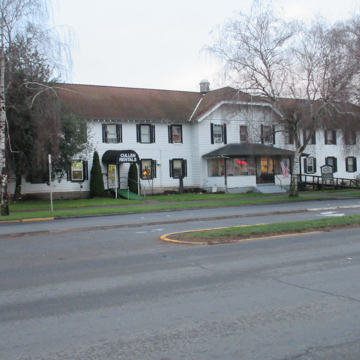You are here
Oregon Way Hotel
The Saint Helens Inn, though altered, is a rare surviving example of the early-twentieth-century industrial housing that was constructed for unmarried male millworkers of the Long-Bell Lumber Company. At the time of the city’s initial development, many of the workers were transient men, and the Saint Helens Inn complex was built to accommodate them.
Originally, the Saint Helens Inn was part of a complex featuring four dormitory buildings including a dining hall with kitchen and recreation facilities. The location was selected due to its proximity to the sawmills, while the nearby Community House (1922–1924, A.N. Torbitt; now the YMCA) was built at 766 Fifteenth Avenue in order to be close to the Saint Helens Inn complex and the Saint Helens Addition housing tract. The site of the Longview Memorial Hospital (1924–1925, George McPherson; now Peace Health Medical Center) at 1524 Douglas Street was similarly located. The two end buildings of the original complex featured an L-shaped footprint and a similar exterior expression to the building’s current configuration as the Oregon Way Hotel, but they were capped with gable roofs.
In 1946, the Long-Bell Lumber Company sold the Saint Helens Inn complex to private parties, after which it was converted to a single-room occupancy hotel. As recently as 1974, three of the original five buildings were still standing. Today, only one remains as a reminder of an industrial housing type that has fallen out of favor and has all but disappeared from the built environment.
Writing Credits
If SAH Archipedia has been useful to you, please consider supporting it.
SAH Archipedia tells the story of the United States through its buildings, landscapes, and cities. This freely available resource empowers the public with authoritative knowledge that deepens their understanding and appreciation of the built environment. But the Society of Architectural Historians, which created SAH Archipedia with University of Virginia Press, needs your support to maintain the high-caliber research, writing, photography, cartography, editing, design, and programming that make SAH Archipedia a trusted online resource available to all who value the history of place, heritage tourism, and learning.




















